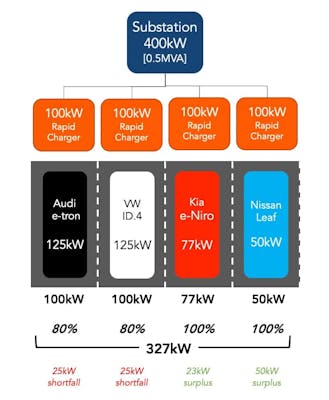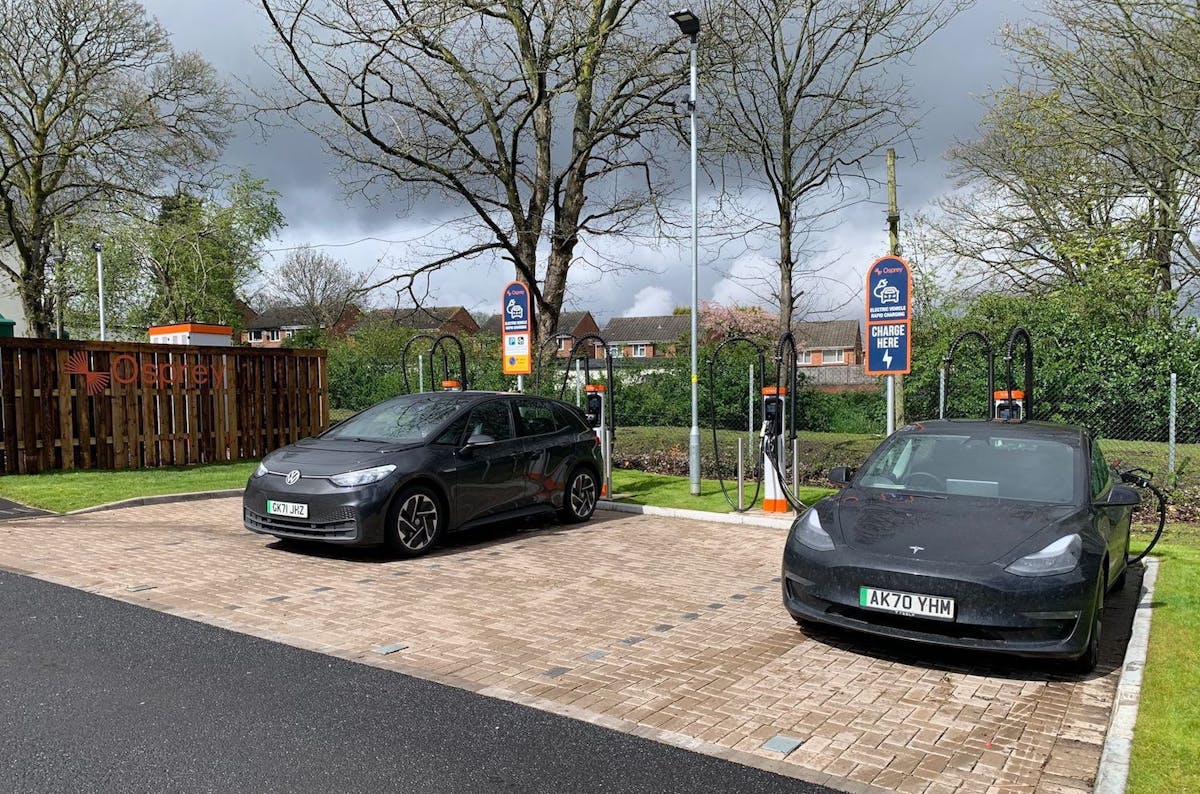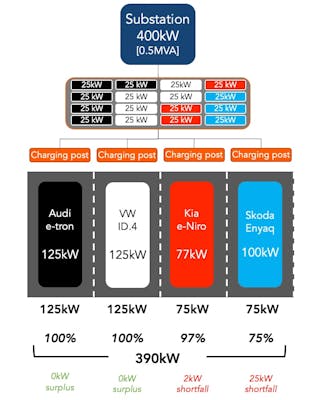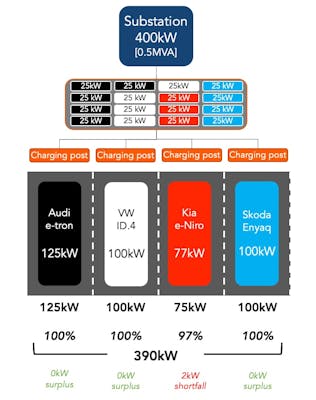Dynamic load-balancing.
A game changer for electric vehicle rapid charging.
Originally published on fullycharged.show by Euan McTurk
Introducing Dynamic Charging Hubs
As we’ve emerged from the COVID lockdown, more and more of us have been driving our electric vehicles (EVs) long distances and looking for places to obtain a fast and convenient charge. Like other charging networks, Osprey is busy expanding its charging sites – both in terms of number of locations and number of chargers at each site – in response to increased demand. However, unlike other charging networks, Osprey is about to launch several new sites that feature some seriously impressive new charger tech, promising speed and convenience for EV drivers.
To build a rapid charging hub, you need to secure a big enough grid supply. With conventional rapid chargers, the total maximum power of all of the chargers installed must not exceed the agreed maximum power supply of the grid connection. Let’s say that we had a grid supply that can provide 400 kW of power. Now let’s try to build a rapid charging hub, first using conventional rapid chargers, then using Osprey’s clever new electron-juggling chargers.
Conventional rapid chargers

For our site, let’s use conventional rapid chargers with 100 kW of power output each: this means that our proposed rapid charging hub could accommodate (400 ÷ 100 = ) four of these rapid chargers without exceeding the site’s grid supply.
Now let’s say that four electric vehicles plugged into our hub. These vehicles are:
- An Audi e-tron 50 quattro with a maximum charge power of 125 kW
- A Volkswagen ID.4 Pro Performance with a maximum charge power of 125 kW
- An Kia e-Niro 64 kWh with a maximum charge power of 77 kW
- A Nissan LEAF 40 kWh with a maximum charge power of 50 kW
Each of our rapid chargers can output 100 kW. This means that the vehicles receive the charging power as shown to the left.
So, the e-tron and the ID.4 are denied their full charging power, despite the e-Niro and LEAF both not fully utilising the power available to them from their chargers. In fact, looking at the power surplus from the e-Niro and LEAF, there is enough spare power to theoretically charge both the e-tron and the ID.4 at their full charging power of 125 kW. Unfortunately, conventional rapid chargers cannot usually share power between other units, and if they can, they tend to split their power in half between the two vehicles, even if one requires a lot more charging power than the other. This problem is exacerbated as the vehicles’ batteries fill up, and their charging power tapers off. If the LEAF’s charging power reduces to 25 kW, there would now be 75 kW of wasted power on that charger.
Whilst conventional rapid chargers continue to serve us well, it’s clear that there’s room to be more clever with our available power.
Kempower’s dynamic load sharing chargers
Osprey is about to launch its latest High-Power Chargers, from a Finnish company called Kempower. These have a number of useful features, the first of which you’ll see as soon as you arrive at the charging hub. Firstly, the cables are six-metres-long and spring-loaded, so they’re easy to lift and should reach the far corner of your car no matter which way you park – no more awkward U-turns having realised that the cable doesn’t reach! The “dispensers” are very compact, so they can be installed in more locations than some conventional chargers, and the cables’ temperature management negates the need for liquid cooling, reducing maintenance requirements and improving reliability.
Osprey have opted for a one-charger-per-bay set up with contactless and both CCS and CHAdeMO on each dispenser. In the near future, things could be even more convenient – Kempower’s chargers are configured for Plug and Charge, so you could simply drive up, plug in and the charging and billing sorts itself out, bringing everyone a level of convenience that so far is largely confined to Teslas.
So far, so convenient, but how are they potentially capable of charging your EV faster than conventional chargers?
The Kempower solution consists of several dispensers, each typically capable of providing up to 125 kW to an EV, all of which are connected to a central power bank. The power bank consists of several 25 kW power modules – in the case of our proposed site, we could have (400 ÷ 25 = ) sixteen of these power modules. The power modules can be assigned to any dispenser as the power bank sees fit, and several modules can be linked up to one dispenser to provide the charging power requested by the EV.The Kempower system constantly monitors the charging power of each EV, and automatically reassigns power modules throughout charging sessions from EVs whose charging power is tapering off, to those that are capable of accepting an extra boost in charging power.
Say our site had four Kempower dispensers. With normal charging infrastructure, installing 4x 125 kW rapid chargers on a 400 kW substation wouldn’t be possible. However, the chances of all four cars pulling 125 kW at the same time are slim – many EVs have a maximum charge power of 100 kW or less, and EVs reduce their charging power as their battery fills up. The Kempower solution takes advantage of this, with some clever electron-juggling in the form of “dynamic load management,” to make the most of its available grid supply without exceeding it, whilst allowing any dispenser to provide more power modules to faster-charging vehicles that need them.
What’s more, you can keep track of your charging session whilst you’re away from your car, without needing an app. The Kempower charger has a clear user interface on its screen, which includes a QR code which brings up details of your charging session on your phone. A summary page shows the State of Charge, charge power and total energy added, and if you really want to geek out, there’s a page with a graph that shows how your charge power and State of Charge have varied over time.
So, the Kempower solution allows a greater number of high-power chargers to be installed on a relatively small grid supply, and reacts to charging power tapering off on one vehicle by automatically reassigning it to another vehicle that needs it. Kempower’s hardware has been tried and tested in Norway, the country with the highest EV uptake per capita, which bodes well for it being able to withstand a constant stream of electric vehicles using the charging hub. It goes without say that, as electric vehicle numbers continue to grow, so will the number and size of charging hubs. Kempower’s electron-juggling could easily play out at sites with tens of dispensers and power modules, and vehicles coming and going constantly. Compared to a conventional charging hub, all of this would happen on a comparatively small grid supply and could potentially give you a faster charge too.
Osprey’s first Kempower sites opened in Wolverhampton in November 2021 and Banbury in February 2022. Looking at what this tech can do with the grid supply it’s given, these sites could easily stake their claim for the title of the smartest high power charging hubs in the UK today.
Our chargers.
We always install the best charger speeds to match the dwell time of each location. Check out the different chargers on the Osprey network.
Insights
Check out more insights from the Osprey team.






